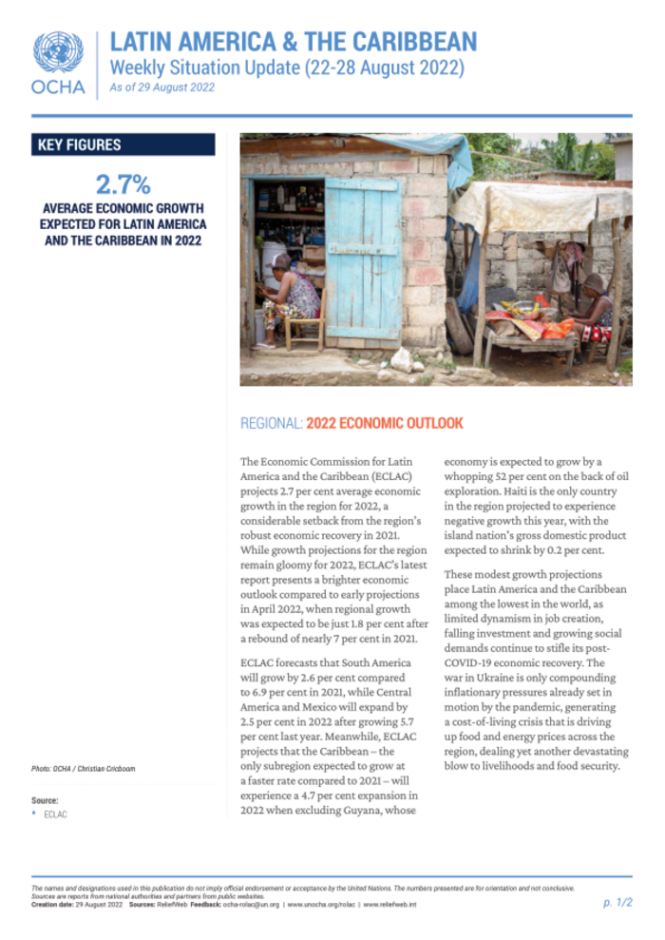
REGIONAL: 2022 ECONOMIC OUTLOOK
The Financial Fee for Latin America and the Caribbean (ECLAC) tasks 2.7 per cent common financial development within the area for 2022, a substantial setback from the area’s strong financial restoration in 2021.
Whereas development projections for the area stay gloomy for 2022, ECLAC’s newest report presents a brighter financial outlook in comparison with early projections in April 2022, when regional development was anticipated to be simply 1.8 per cent after a rebound of almost 7 per cent in 2021.
ECLAC forecasts that South America will develop by 2.6 per cent in comparison with 6.9 per cent in 2021, whereas Central America and Mexico will increase by 2.5 per cent in 2022 after rising 5.7 per cent final yr. In the meantime, ECLAC tasks that the Caribbean – the one subregion anticipated to develop at a sooner charge in comparison with 2021 – will expertise a 4.7 per cent growth in 2022 when excluding Guyana, whose financial system is anticipated to develop by a whopping 52 per cent on the again of oil exploration. Haiti is the one nation within the area projected to expertise destructive development this yr, with the island nation’s gross home product anticipated to shrink by 0.2 per cent.
These modest development projections place Latin America and the Caribbean among the many lowest on this planet, as restricted dynamism in job creation, falling funding and rising social calls for proceed to stifle its postCOVID-19 financial restoration. The struggle in Ukraine is just compounding inflationary pressures already set in movement by the pandemic, producing a cost-of-living disaster that’s driving up meals and vitality costs throughout the area, dealing one more devastating blow to livelihoods and meals safety.
KEY FIGURES
2.7% AVERAGE ECONOMIC GROWTH EXPECTED FOR LATIN AMERICA AND THE CARIBBEAN IN 2022
Supply:
• ECLAC
COLOMBIA: CONFINEMENT, DISPLACEMENT AND DISASTERS
In 2022, the humanitarian scenario in Colombia continues to worsen as pressured displacement and confinement proceed to develop in areas the place there’s a presence, interference or measure of management being exercised by non-state armed teams (NSAGs), a scenario aggravated by intensified climatic shocks throughout the nation in current months.
From January to July 2022, at the very least 220 emergencies triggered by displacement, confinement and disasters affected round 456,400 individuals, who required elevated humanitarian help from companions of the Humanitarian Nation Workforce (HCT). Though HCT companions have scaled-up multi-sectoral response actions, Native Coordination Groups in areas affected by a number of overlapping emergencies report that rising humanitarian wants proceed to outstrip response capacities, whereas the presence of NSAGs continues to create extreme humanitarian entry constraints.
Between January and July 2022, the variety of households affected by huge displacement occasions elevated by 25 per cent in comparison with the identical interval final yr, with the south-eastern division of Nariño accounting for almost 40 per cent all victims of pressured displacement within the nation. Since 2021, greater than 249,000 individuals have been forcibly displaced throughout Colombia, a determine that continues to rise unabated.
UN businesses and humanitarian companions are notably involved about some 59,800 individuals displaced since 2021, who’ve been unable to return to their locations of origin as a result of persistent insecurity in areas with a everlasting presence of NSAGs. To date in 2022, at the very least 6,400 kids have been forcibly displaced, exposing them to safety dangers, together with genderbased and sexual violence, faculty dropout and deprivations of primary wants in meals, well being and shelter.
Alongside the rise in pressured displacement between January and July, the variety of individuals affected by pressured confinement has additionally risen by a staggering 74 per cent in comparison with the identical interval in 2021, with round 77 per cent of the individuals affected by pressured confinement situated within the north-eastern division of Chocó.
Greater than 70 per cent of victims of pressured confinement belong to ethnic communities, with indigenous and afro-descendent communities affected by restrictions on conventional livelihood actions and intimidation of unaccompanied ladies and ladies.
Since June, the La Niña-driven wet season has considerably intensified, triggering large-scale flooding and landslides throughout the nation’s 32 departments, additional complicating an already-complex humanitarian scenario. As of August 2022, at the very least 343,800 individuals have been affected by pure hazard-related disasters, with increased ranges of influence and wishes projected within the coming weeks and months as intense rains are more likely to persist in sure areas. The Institute of Hydrology, Meteorology and Environmental Research warns that there’s a 64 per cent likelihood that La Niña will proceed by way of September, notably affecting the Andean and Caribbean areas of the nation.
KEY FIGURES
456.4K AFFECTED BY CONFINEMENT, DISPLACEMENT AND DISASTERS BETWEEN JANUARY AND JULY 2022
249.1K+ PEOPLE FORCIBLY DISPLACED IN COLOMBIA SINCE 2021
74% INCREASE IN THE NUMBER OF PEOPLE AFFECTED BY FORCED CONFINEMENT (JANUARY-JULY 2022) COMPARED TO THE SAME PERIOD IN 2021
Sources:
• Colombia Humanitarian Nation Workforce
• Monitor-OCHA Colombia
• Particular Administrative Unit of Consideration and Reparation for Victims (UARIV, for its acronym in Spanish)
Disclaimer
- UN Workplace for the Coordination of Humanitarian Affairs
- To study extra about OCHA’s actions, please go to https://www.unocha.org/.
